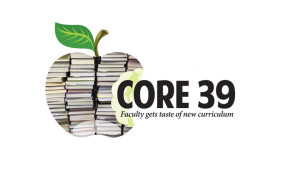 As students scramble to beat the rush and high tail it into courses they need to graduate, advisers are scrambling to learn a new core curriculum, which requires 39 credit hours rather than 50.
As students scramble to beat the rush and high tail it into courses they need to graduate, advisers are scrambling to learn a new core curriculum, which requires 39 credit hours rather than 50.
Core 39 doesn’t roll out until fall 2014, but new student orientation begins today.
The university has offered weekly Core 39 training sessions to all faculty advisers since early February.
Associate Professor of Anthropology Michael Strezewski attended a session about a month ago.
“There are going to be some bumps, as there are with all things that are brand new,” he said. “But it’s pretty straight forward.”
He said things should go smoother once faculty finishes populating the new core and the Provost’s Office, who must approve all courses, gets a list nailed down.
Most of Strezewski’s advisees, though, won’t have to worry about Core 39 because most of his advisees are upperclassman and they’re finishing up the university core curriculum (UCC), which has existed for more than 15 years.
“It’s something that’s going to take some practice,” he said. “With any system like this, there are exceptions to the rule – little rules you might not know from the get go.”
Strezewski said he’s been advising with the UCC long enough to know the ins and outs of it.
But Core 39 was necessary in order to cut down the number of hours students were required to take as part of a core curriculum, he said.
The new core requires fewer credit hours, so students will be able to pick up a second minor or double major.
“It was a lot of work for everybody to get it together,” Strezewski said. “I think there is a pretty good mix of courses.”
Since the USI Faculty Senate approved the framework for Core 39 last year, the University Core Curriculum Council has been shuffling through faculty petitions for courses to become part of the new core.
As of February, more than 150 courses were approved, said Mark Krahling, university core curriculum director.
“Normally this is a four or five year – or more than that – process,” Krahling said. “We actually did it in just about three years – we were trying to do things pretty quickly.”
A modern core curriculum should be a “vertically integrated core,” Krahling said. It includes components students are expected to take during their junior and senior years.
“One of the things that we’ve done with the new core is make a bigger distinction between students who are pursuing a Bachelor of Arts or a Bachelor of Science degree,” he said.
Core 39 includes a greater emphasis on global awareness, too.
“While there was a global requirement in our old core, this one actually expects (students) to do more analysis on global issues,” Krahling said.
Both a first year experience and an embedded experience were added to the new core as well.
The embedded experience requires intensive writing courses during a student’s junior and senior year. Students majoring in writing intensive programs, such as English and journalism, will fulfill the requirement within their major, while students in programs that aren’t writing intensive have the option to fulfill the requirement within other core areas.
“(Students) shouldn’t have to take any additional course work if (they’re) deliberate about the choices (they) make,” Krahling said.
A lot of current students won’t make the switch.
“It’s very important that every student have a very candid conversation with their adviser about whether it would be to their benefit or not,” Krahling said.
He recommends advisers who haven’t attended a session or still have questions to contact a representative from the core curriculum council.
First Year Experience:
This course is an introduction to the University of Southern Indiana and the undergraduate experience with a specific focus on academic success, campus involvement and community engagement. Students will discuss issues of value and behavior in the college setting, discover what resources are available to them, and learn what it means to integrate themselves into the campus and surrounding communities.


